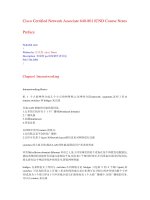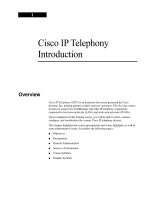Tài liệu Cisco Systems - Determining IP routes doc
Bạn đang xem bản rút gọn của tài liệu. Xem và tải ngay bản đầy đủ của tài liệu tại đây (813.79 KB, 28 trang )
© 2002, Cisco Systems, Inc. All rights reserved.
© 2002, Cisco Systems, Inc. All rights reserved. 2
Determining IP Routes
Module 5
© 2002, Cisco Systems, Inc. All rights reserved. ICND v2.0—5-3
Objectives
Upon completing this lesson, you will be able to:
•
Describe the features and operation of static routing
•
Describe the features and operation of dynamic routing
protocols, including RIP, IGRP, EIGRP,
and OSPF
•
Build a functional router configuration to support the
specified network operational requirements, given a
network design
•
Use show commands to identify anomalies in routing
operation, given an operational router
•
Use debug commands to identify events and anomalies in
routing operation, given an operational router
© 2002, Cisco Systems, Inc. All rights reserved. ICND v2.0—5-4© 2002, Cisco Systems, Inc. All rights reserved. 4
Routing Overview
© 2002, Cisco Systems, Inc. All rights reserved. ICND v2.0—5-5
Objectives
Upon completing this lesson, you will be able to:
•
Explain the differences between static routing and
dynamic routing
•
Identify the classes of routing protocols
•
Use Cisco IOS commands to configure static routes and
default route forwarding, given a functioning router
•
Use show commands to identify anomalies in static
routing operation, given an operational router
•
Describe the operation of “router on a stick”
•
Configure router on a stick for inter-VLAN routing using
ISL and 802.1Q trunking, given an operational switch and
router
© 2002, Cisco Systems, Inc. All rights reserved. ICND v2.0—5-6
To route, a router needs to do the following:
•
Know the destination address
•
Identify the sources it can learn from
•
Discover possible routes
•
Select the best route
•
Maintain and verify routing information
What Is Routing?
© 2002, Cisco Systems, Inc. All rights reserved. ICND v2.0—5-7
•
Routers must learn destinations that are
not directly connected.
What Is Routing? (Cont.)
© 2002, Cisco Systems, Inc. All rights reserved. ICND v2.0—5-8
Static Route
•
Uses a route that a
network administrator
enters into the router
manually
Dynamic Route
•
Uses a route that a
network routing
protocol adjusts
automatically for
topology or traffic
changes
Identifying Static and Dynamic Routes
© 2002, Cisco Systems, Inc. All rights reserved. ICND v2.0—5-9
Static Routes
•
Configure unidirectional static routes to and from
a stub network to allow communications to occur.
© 2002, Cisco Systems, Inc. All rights reserved. ICND v2.0—5-10
•
Defines a path to an IP destination network or subnet or host
Router(config)#ip route network [mask]
{address | interface}[distance] [permanent]
Static Route Configuration
© 2002, Cisco Systems, Inc. All rights reserved. ICND v2.0—5-11
Static Route Example
•
This is a unidirectional route. You must have a route
configured in the opposite direction.
© 2002, Cisco Systems, Inc. All rights reserved. ICND v2.0—5-12
Default Routes
•
This route allows the stub network to reach all known
networks beyond router A.
© 2002, Cisco Systems, Inc. All rights reserved. ICND v2.0—5-13
Verifying the Static
Route Configuration
router#show ip route
Codes: C - connected, S - static, I - IGRP, R - RIP, M - mobile, B - BGP
D - EIGRP, EX - EIGRP external, O - OSPF, IA - OSPF inter area
E1 - OSPF external type 1, E2 - OSPF external type 2, E - EGP
i - IS-IS, L1 - IS-IS level-1, L2 - IS-IS level-2, * - candidate default
U - per-user static route
Gateway of last resort is 0.0.0.0 to network 0.0.0.0
10.0.0.0/8 is subnetted, 1 subnets
C 10.1.1.0 is directly connected, Serial0
S* 0.0.0.0/0 is directly connected, Serial0
© 2002, Cisco Systems, Inc. All rights reserved. ICND v2.0—5-14
•
Routing protocols are
used between
routers to determine
paths and maintain
routing tables.
•
Once the path is
determined, a router can
route a routed protocol.
What Is a Routing Protocol?
© 2002, Cisco Systems, Inc. All rights reserved. ICND v2.0—5-15
•
An autonomous system is a collection of networks
under a common administrative domain.
•
IGPs operate within an autonomous system.
•
EGPs connect different autonomous systems.
Autonomous Systems: Interior or
Exterior Routing Protocols
© 2002, Cisco Systems, Inc. All rights reserved. ICND v2.0—5-16
Administrative Distance:
Ranking Routes
© 2002, Cisco Systems, Inc. All rights reserved. ICND v2.0—5-17
Classes of Routing Protocols
© 2002, Cisco Systems, Inc. All rights reserved. ICND v2.0—5-18
Classful Routing Overview
•
Classful routing protocols do not include the
subnet mask with the route advertisement.
•
Within the same network, consistency of the
subnet masks is assumed.
•
Summary routes are exchanged between foreign
networks.
•
Examples of classful routing protocols:
–
RIP Version 1 (RIPv1)
–
IGRP
© 2002, Cisco Systems, Inc. All rights reserved. ICND v2.0—5-19
Classless Routing Overview
•
Classless routing protocols include the subnet mask
with the route advertisement.
•
Classless routing protocols support variable-length
subnet masking (VLSM).
•
Summary routes can be manually controlled within
the network.
•
Examples of classless routing protocols:
–
RIP Version 2 (RIPv2)
–
EIGRP
–
OSPF
–
IS-IS
© 2002, Cisco Systems, Inc. All rights reserved. ICND v2.0—5-20
Routing Protocol
Comparison Chart
© 2002, Cisco Systems, Inc. All rights reserved. ICND v2.0—5-21
Using the ip classless Command
© 2002, Cisco Systems, Inc. All rights reserved. ICND v2.0—5-22
VLAN-to-VLAN Overview
•
Network layer devices combine multiple
broadcast domains.
© 2002, Cisco Systems, Inc. All rights reserved. ICND v2.0—5-23
Dividing a Physical Interface into
Subinterfaces
•
Physical interfaces can be divided into multiple
subinterfaces.
© 2002, Cisco Systems, Inc. All rights reserved. ICND v2.0—5-24
Routing Between VLANs
with ISL Trunks
© 2002, Cisco Systems, Inc. All rights reserved. ICND v2.0—5-25
Routing Between VLANs
with 802.1Q Trunks









